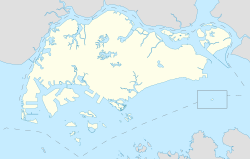
Bishan, Singapore
Planning Area and HDB Town in Central Region, Singapore / From Wikipedia, the free encyclopedia
Dear Wikiwand AI, let's keep it short by simply answering these key questions:
Can you list the top facts and stats about Bishan, Singapore?
Summarize this article for a 10 year old
Bishan (/ˈbiːʃɑːn/), also known as Peck San, Bishan New Town or Bishan Town, is a planning area and matured residential town located at the northernmost portion of the Central Region of Singapore. Statistically, the area is ranked the 38th biggest in terms of geographical size and the 22nd most populated planning area in the country. It is located at the most Central point of Singapore, and it comprises Upper Thomson, Marymount, Shunfu, Sin Ming, Bishan North and Bishan East. There are also many private residential properties in Bishan.[5] Bishan is ranked 15th in terms of population density.[3] Apart from its boundary with the Central Water Catchment in the west, Bishan borders three other planning areas: Ang Mo Kio to the north, Toa Payoh to the south, and Serangoon to the east.[6]
Bishan | |
|---|---|
| Other transcription(s) | |
| • Chinese | 碧山 Bìshān (Pinyin) Phek-san (Hokkien POJ) Bīk-sāan (Cantonese Yale) |
| • Malay | Bishan |
| • Tamil | பீஷான் Pīṣāṉ (Transliteration) |
From top left to right: Aerial panorama of Bishan-Ang Mo Kio Park, Aerial view of Bishan Town Centre, Bishan Depot, Guide House of the Girl Guides Singapore, Bishan Stadium, Raffles Institution, Bishan at night | |
 Location in Central Region | |
| Coordinates: 1°21′3″N 103°51′5″E | |
| Country | |
| Region | Central Region
|
| CDC | |
| Town council |
|
| Constituency | |
| Development begins |
|
| Town completed |
|
| DGP exhibited |
|
| PA incorporated |
|
| Government | |
| • Mayor | Central Singapore CDC
|
| • Members of Parliament | Bishan-Toa Payoh GRC
Marymount SMC |
| Area | |
| • Total | 7.62 km2 (2.94 sq mi) |
| • Rank | 38th |
| • Residential | 1.72 km2 (0.66 sq mi) |
| Population | |
| • Total | 88,120 |
| • Rank | 22nd |
| • Density | 12,000/km2 (30,000/sq mi) |
| • Rank | 15th |
| Ethnic groups | |
| • Chinese | 77,220 |
| • Malays | 3,760 |
| • Indians | 7,000 |
| • Others | 2,720 |
| Postal district | 20 |
| Dwelling units | 20,072 |
| Projected ultimate | 34,000 |
What is now Bishan today was once land that belonged to Kwong Wai Siew Peck San Theng, a century old cemetery that mainly served the Cantonese and Hakka communities in Singapore. Following the establishment of the cemetery in 1870, the first human settlements began to appear in the area, forming what eventually became Kampong San Teng.[1][7] During the Battle of Singapore in 1942, Peck San Theng was the site of a fierce firefight between the invading Japanese forces and the defending British.[1][8] The subsequent fall of the island to the Japanese that same year eventually made Peck San Theng a place of refuge for most of the Singapore population.[9] In 1973, Peck San Theng ceased accepting burials, and six years later, following a government lease, the land was acquired for development.[10] Graves were then exhumed between 1982 and 1984, paving the way for the construction of Bishan New Town in 1983.[1] Today, Peck San Theng remains in operation, although it has since been converted into a columbarium.
Bishan New Town became the first in Singapore to depart from the brutalist design seen in most previous Housing and Development Board (HDB) towns. Instead of slab-like residential blocks that were built in uniformed rows, apartment blocks in Bishan varied in height and were often dislocated. Flats within the town also featured pitched roofs which have since become closely associated with the skyline of Bishan.[1][7] The town is also home to three of Singapore's most prestigious educational institutions: Catholic High School, Raffles Girls' School, and Raffles Institution.[7][11]







